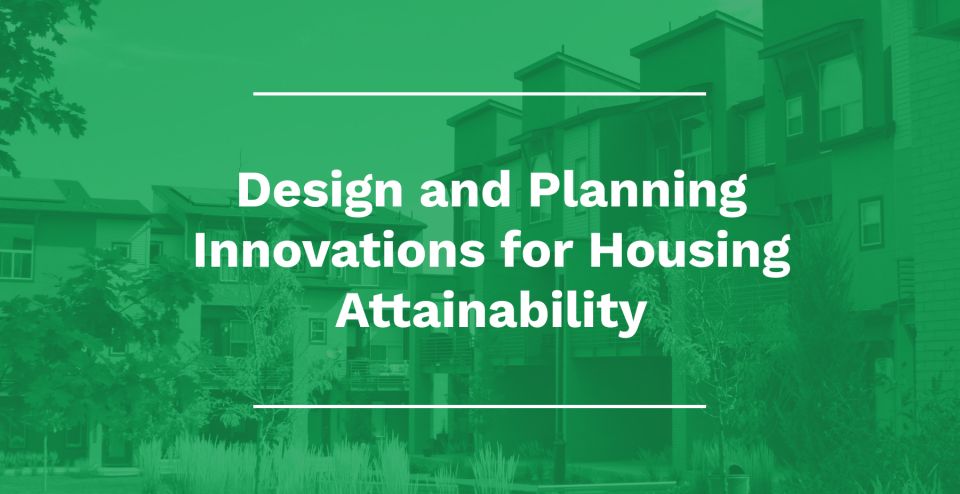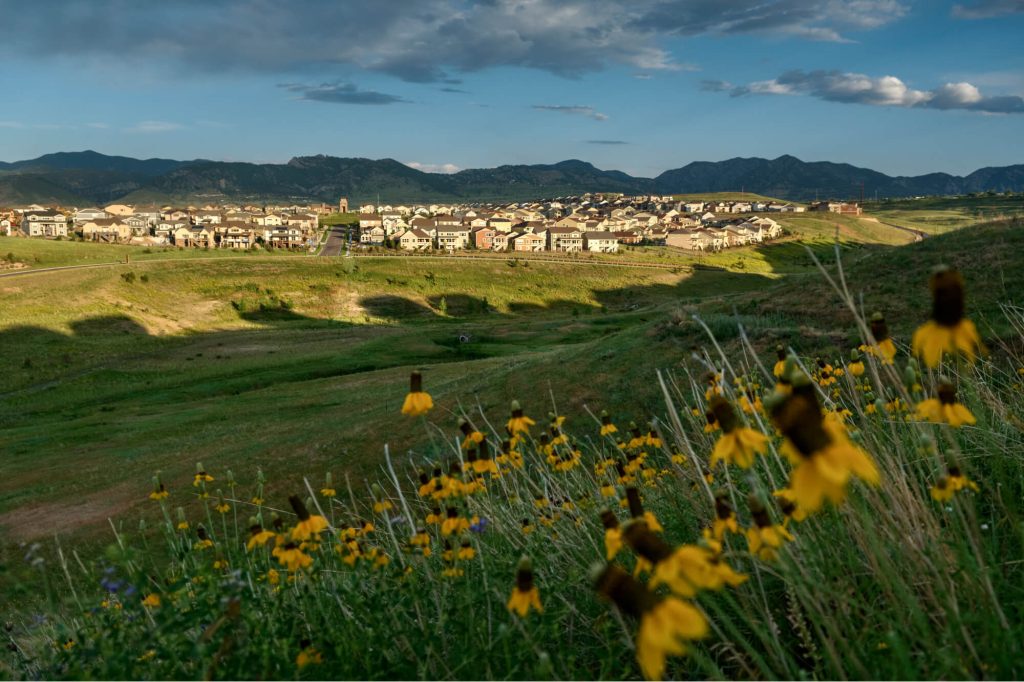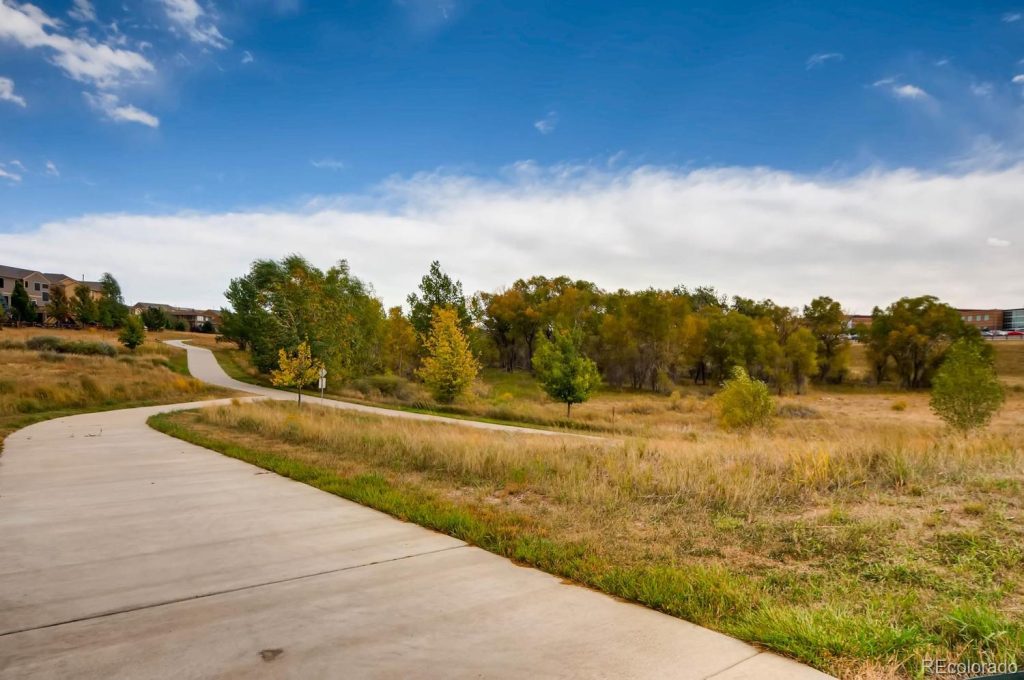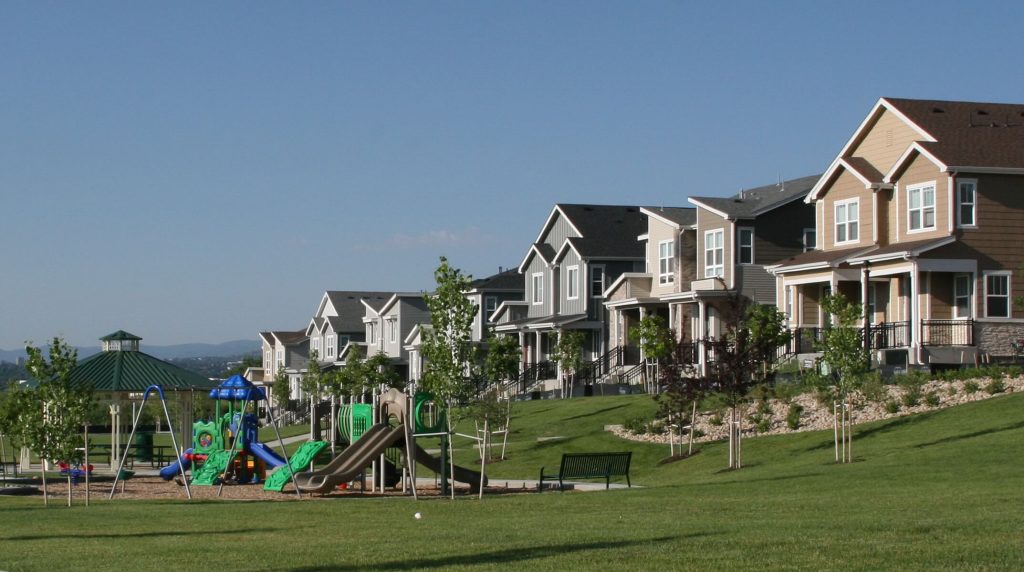
Innovative approaches to neighborhood and community planning and design can significantly contribute to housing attainability. The following are ways to achieve attainability with innovative neighborhood and community planning and design.

Low Impact Design
Successful low impact neighborhood and community design is more than just building ever bigger houses on ever smaller lots. Low impact design reduces infrastructure costs while maximizing open space and protecting vital habitat, historical, and cultural features of the site. Thereby, creating a sense of place-an amenity valued more than ever by homebuyers and community stakeholders.
Low impact design contributes to attainability by:
- Reducing the overall development footprint and increasing density. A great example of this is at Leyden Rock in Arvada, Colorado, where low-impact site design resulted in 40% higher density than conventional development in the surrounding area while preserving 3 times as much open space.
- Reducing the linear feet of street and utility improvements per home, resulting in lower infrastructure costs.
- Using shared drives, loop lanes, and “Woonerfs” (living streets) for access to homes reduces the number of streets needed for access and the impervious surface area, providing both economic and environmental benefits.
- Reducing the amount of impervious surface in streets, walks and drives reduces the extent and cost of stormwater infrastructure required and leaves more area in the landscape leading to increased infiltration and reduced runoff.
- Planning compact lots and xeric landscape design, which reduces the expense of water and maintenance costs to the homeowner.

Design For All Life Stages
Attainability is an issue for all homebuyers, not just first-time buyers. Designing communities for all life stages contributes to housing attainability by broadening the type of homes and range of costs available to homebuyers. People at different life stages have different housing needs, financial goals, and resources. The needs and finances for a first-time homebuyer may be significantly different than an active adult move-down buyer.

Simplify the Landscape and Preserve Open Space.
Preserving the existing landscape whenever possible ensures it is the most affordable and resilient landscape in a community. Restoring disturbed areas with native landscape whenever possible promotes affordable installation and maintenance.
Be judicious with amenity improvements. The most important and desirable amenity for neighborhoods and communities is space, but it doesn’t need to be filled with all the latest trends. Create simple, cost-effective spaces that will continue to benefit the community and a wide range of users as time passes and resident demographics change.

Light Touch Density
The most affordable homes, neighborhoods, and communities in the United States are the ones we already have. We cannot build our way to attainability solely by building large single-family home communities within greenfield development or with high-density development in the urban core. New home and infrastructure construction costs are the highest they have ever been, and it is highly unlikely they will go down anytime soon. It is counterintuitive to think we can use the most expensive construction costs, often combined with significant political resistance (Nimbys) to meet our attainable housing needs.
Edward Pinto, Director, AEI Housing Center made an outstanding presentation about Light Touch Density (LTD) at the 2023 NAHB spring meetings in Washington DC this past June. Here’s what was learned from his presentation:
- LTD is a naturally affordable and inclusionary pattern of development that was commonplace 100 years ago. It’s the triple-deckers of Boston, the row houses of Philly and San Francisco, the brownstones of New York, and the various larger (but still generally walk-up) apartment buildings interspersed into that fabric. Moderately higher density and use by right zoning allows the free market to add substantially to supply. It drives smaller incremental investments by thousands of owners, developers, builders, and others, which allows for flexibility, resiliency, and mid-course correction based on feedback as opposed to relying on fewer, expensive mega projects, often in suburban or exurban locations.
- LTD does not require subsidies, inclusionary zoning, income limits, rent caps, or complex plans.
- LTD housing promotes filtering down, which does not happen when expensive housing projects built in limited quantities dominate the market. Instead, it works best when masses of homes are produced at or below the middle of the price spectrum.
- LTD homes can have substantially lower prices and rents than single-family detached homes or large multifamily projects and adds more supply, diversity in form, and size choices for lower income households. LTD allows for more efficient use of existing and new infrastructure and generates higher tax yield per acre.
Light-Touch Density is useful in modestly increasing density in multiple ways:
- In-fill: providing additional units such as an accessory dwelling unit (ADU) or adding a second unit to an existing single-family detached lot.
- In-fill: tearing down an existing unit and replacing it with duplexes, triplexes, quadraplexes, or townhouses.
- In-fill: a lot-split to allow increased density.
- Greenfield: increasing as-built density.
- Greenfield and Infill: increasing density by adding additional floor(s) or reducing the size of the units in a planned new apartment or condo building.
All these LTD strategies would moderately increase the as-built density of the land, thereby enabling owners/builders to construct smaller, less expensive units that are more naturally affordable & inclusionary without requiring subsidies.
Daniel Herriges is Editor-in-Chief for Strong Towns. His recent article in Strong Towns, “What’s the “Sweet Spot” For Building Housing Inexpensively?” supports the concept of Light-touch Density.
Overdependence on high density housing can be counterproductive to affordability. Mid and high-rise construction technology is generally the most expensive construction form used in home building, and it is often built on the most expensive residentially zoned property in the marketplace, yet many communities focus their housing goals solely on this housing form. Most missing middle homes use basic construction techniques and doesn’t require features like elevators, steel-frame construction, or structured parking that add expense and complexity.
On the opposite end of the supply spectrum is the single-family home. In most parts of the country, new single-family homes are constructed in suburban conditions. Land may be more affordable, but water and infrastructure expansion costs add significantly to land cost, and ultimately, home cost. Exorbitant tap fees and other impact fees further drive up the per-home cost of building which then pushes builders to build larger homes to offset these costs. Adding supply at the high end yields few new homes and fewer move-ups from less expensive housing. Think of it this way: Imagine if car manufacturers could only legally build Ferraris. Filtering down would be limited as few new cars would be sold, existing car prices would sky-rocket, and few could afford new or used cars.
The sweet spot for affordability is in “Missing Middle” housing, in all its forms from duplexes to small apartment buildings, as well as other arrangements like cottage courts.
It can fit on a regular urban lot, without the developer needing to buy up multiple lots to combine them, and can be done by a relatively small-scale, semi-amateur developer without a huge amount of capital. LTD adds to supply in the middle and yields a greatly increased number of move-ups from less expensive existing housing—making the most affordable housing we have attainable for new homeowners or renters. It offers many more ownership opportunities, helps close the socio-economic status wealth gap, and reduces homelessness.
Low impact design, design for all life stages, simplifying the landscape and preserving open space, and light touch density all can play a part in providing more attainable and sustainable homes, neighborhoods, and communities.